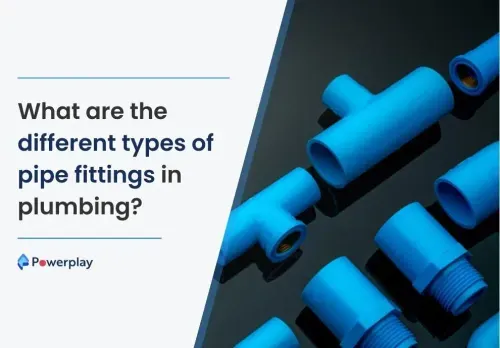What are the different types of pipe fittings in plumbing?
-
Kumar Abhishek Anand
- October 23, 2023

The plumbing process for every building structure includes several pipe fittings, each having its function and importance as per the design requirement. Pipe fittings are used as part of the plumbing system to connect multiple pipes of the same or different sizes. They assist in controlling and measuring the flow of water and sewage. These connecting components are usually copper, PVC, iron or brass.
Types of Pipe Fittings
Every individual pipe fitting has a distinct function to perform. Below have been listed the different types of pipe fittings:
1. Elbow Fittings
2. Reducer Fittings
3. Tee Fitting
4. Cross Fittings
5. Coupling
6. Unions
7. Adaptors
8. Olet
9. Plug
10. Caps
11. Valves
1. Elbow Fittings
Elbow fittings are included between two pipes to change the direction of flow. They are available in different angle sizes of 22.5o, 45o and 90o. These fittings come with female threading used to fix them with butt or socket welding.
Elbows are made of different materials such as copper, PVC, steel, etc. Normal elbows are used if the two connecting pipes have the same diameter, and reducer elbows are used if the two have different diameters.
2. Reducer Fittings
As the name suggests, reducer fittings reduce the flow capacity from a larger to a smaller pipe by reducing the diameter. The velocity increases as the area of flow through a pipe increases.
The concentric reducer fittings that are cone-shaped reduce the diameter around the pipe. This type of arrangement used in a fitting may cause an accumulation of air resulting in cavitation. On the other hand, eccentric reducer fittings have one edge parallel to the connecting pipes that prevent the accumulation of air and subsequent cavitation.
3. Tee Fitting
Tee fittings are in the shape of a ‘T’. Given its shape, it has two outlets and one inlet. The inlet is orthogonal to both outlets, perpendicular to the mainline. In other cases, Tee fittings are also used to merge the flow from two inlets into one outlet.
Tee fittings are available in different sizes and are made of copper, PVC, steel, etc. All three sides of tee fittings are equal in an Equal Tee and unequal in an Unequal tee.
4. Cross Fittings
Cross fittings have four openings in four directions perpendicular to each other. These fittings are used to connect four-pipe flows meeting at a point.
As it is placed at the centre of four pipes, there is more stress on the cross fitting when the temperature changes, causing excess heat. These fittings are most commonly used for sprinkler systems.
5. Coupling
A coupling is more of a plumbing arrangement utilised to connect two pipes having the same diameter. It is usually installed when the pipe is broken or a leakage point. The affected section of a pipe is cut off with some extra length and replaced with a coupling to repair it.
Coupling is mainly of two types, compression and slip coupling. Compression coupling is used in normal conditions when two pipes are connected to prevent leakage due to rubber or gasket seals on both sides. Sometimes, even glue is used to prevent leakage.
Slip coupling is easy to fit between two pipes arranged as a single pipe by inserting the smaller pipe into the larger pipe.
6. Unions
Unions are similar to a coupling, the only difference being that coupling cannot be removed once it is installed, but unions can be removed whenever needed.
Unisons have three simple parts, the nut, male and female ended threads.
7. Adaptors
Adaptors are an extension added to pipes not having plain or special ends to make them threaded as male or female as required in the plumbing process. These end connectors are commonly used for copper or PVC pipes.
The other plain end of the adaptor is either glued, welded, or soldered to the end of the plain pipes.
8. Olet
When the standard sized fittings are not suitable for the plumbing requirements, olets are used. Several types of olets are used in plumbing tasks:
a. Butt-Weld Olet
b. Socket Weld Olet
c. Elbow Olet
d. Nipple Olet,
e. Lateral Olet
f. Flange Olet
g. Sweep olet and
h. Threaded Olet
9. Plug
Plugs are used in plumbing to close the pipe opening during repairs and inspection, and they normally include male threads.
10. Caps
Caps are similar to plugs, and the only difference is that plugs have male threads, and caps have female threads fixed to the threaded end of pipes.
11. Valves
Valves in construction are used to regulate or stop the liquid flow while moving within the pipe.
Several valves are available: globe valves, diaphragm valves, gate valves, butterfly valves, and check valves.
Share
Kumar is a digital content professional with more than 2 years of experience in Blog writing, copywriting and scripting. His passion lies in the art of creating convincing content that plays a major role in converting leads for SAAS businesses.












